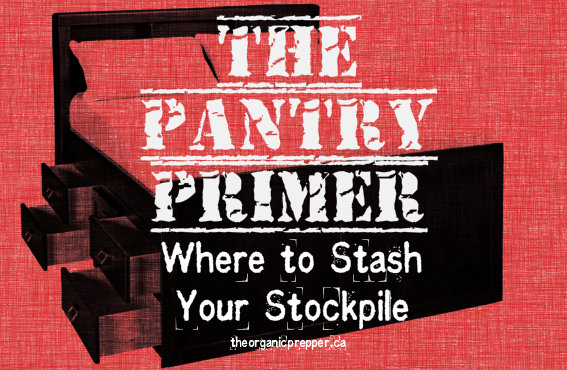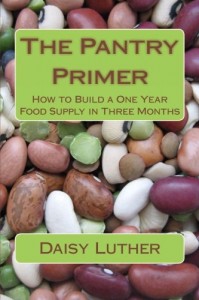If you're new here, you may want to subscribe to my RSS feed. Thanks for visiting!
Stockpiles: they aren’t just for pantries anymore!
You might be wondering where on earth you can stash all of the food required for a one-year pantry. Unless you have a pantry the size of a master bedroom suite, it won’t take long to exceed the limits of your available kitchen storage. But don’t despair! There are lots of little nooks, crannies, and storage areas around most homes that will allow you to discreetly put away a year’s supply of food for your family. Even those who dwell in apartments or other small spaces might be surprised to discover how many little hidden areas they actually have.
When you store things in different places throughout the house, it’s important to store like items together and to document your organizational efforts with a “map”. Without this guideline, you may find yourself wasting valuable time searching for a package of flour that you know you packed away or repurchasing items that you already have, but just can’t find.
Get organized!
Set aside a day (or weekend) to get organized. This is a big, messy undertaking, so choose a day where you won’t be constantly interrupted and can work until you’re finished.
- Pull all of your preps into one room.
- Separate them into like items: grains, paper products, baking supplies, jarred goods, etc.
- Clean out your nooks and crannies in which you plan to stash away your items.
- Make a map documenting where you store each item
- Put the food away, oldest items at the front.
Your “map” can also serve as a running inventory. It can be constantly updated with the amounts of items you are putting away and taking for use in the kitchen. If you plan to update like that, consider a dry-erase board hung on the inside of the pantry door. Keeping your map on the computer is a great idea….unless the grid goes down. It’s important to have a hard copy for that reason.
Where Can You Store Your Goods?
Every room in the house is fair game. There’s no reason that food must only be stored in the kitchen. Keep similar items together, for the sake of organization. Think about the grocery store – it’s generally easy to find items because similar things are organized together. There is a condiment aisle, as cereal aisle, etc. You can apply this principle to your home storage also.
Beware of extremes in temperature, moisture, and rodents and other pests and store items in the past possible environment for their shelf longevity.
Here are some places that I store preps in my home, along with ideas from previous places we have lived.
- Kitchen Pantry
- Kitchen shelves
- Broom Closet
- Blanket Storage area in guest room sofa
- Armoire in guest room
- Mudroom
- Basement
- Garage
- Attic
- Laundry room closet
- Laundry room shelf
- Living room bookcases
- Front hall closet
- Linen closet
- Bedroom closets
- Under beds
- Storage furniture
- Outbuildings
When coming home from a shopping trip, I always put the new supplies away in the correct spot, rotating the older items to the front. Each week I “shop” the food storage and rotate needed items into the kitchen. Since I’ve begun doing it this way, I have never run into the issue of having preps slip through the expiration date cracks, nor have I had to dig through anything to find a needed item!
Prepper OPSEC 101
It is important to maintain your OPSEC when stashing away your food. OPSEC is a term swiped from the military that means OPerational SECurity. It means that your operations, in this case, your one year supply of food, should not be public knowledge. OPSEC is the process of protecting little pieces of data that could be grouped together to give the bigger picture. “OPSEC is the process of protecting little pieces of data that could be grouped together to give the bigger picture.” (source)
In the event of a long term disaster, your neighborhood will be filled with hungry people. Even in a short term disaster, as we saw in the aftermath of Hurricane Sandy, some people are without food after only 2-3 days. You don’t want your home to be known as the one with all the food. During an event of civil unrest, you could become a target.
What about you?
Where do you store your stashes of food and supplies? Share your ideas in the comments section below!
Want to learn more? My new book is now available!
Lots of us like to have hard copies of information that we’ve found helpful. Because of this, I’ve expanded on the information included in this series and put it all in one handy primer, available on Amazon.
The Pantry Primer: How to Build a One Year Food Supply in Three Months

















6 Responses
Build a false bedframe put mattress on top, yes it would be a pain but you would food so worth the trouble. You could even build it inside your bedframe so it wouldn’t look built in. Build false backings everywhere closets,kitchen cabinets,stairwells,under sofa and chairs, under the kitchen table for small things like tuna and canned meats? Behnd wardrobes and entertainment centers? Just a thought.
I recently moved our water storage to the bedroom. The one gallon containers fit under the bed, but the 3 gallon and cases of bottles didn’t fit, but DID fit nicely on the empty shelves in the TV stand! My food is mostly in the pantry and kitchen right now, but want to work on spreading it out around the house and having a ‘false’ supply just in case. Right now, my home office is the current repository of my medical supplies and a lot of the miscellaneous stuff I’ve been picking up. I still have a lot of organizing to do. And an inventory list is also something I have added to the to-do list. We don’t have a full year supply of anything, but we are working on that.
these are all great ideas. I’m pretty new but I taught myself to can a couple yrs ago and we are healthy be
cause of it. but I like the prepping idea it just makes sense. love your site
Fake bed food storage. Put a bed frame up stack cartons 2 to 3 foot high with your foods put a sheet and blanket and two pillows on the bed or even put on a 2 inch mattress cover first. looks like a bed no one would ever think it was stored foods.
MARK W
What happens when your house burns down and all your hard work goes up in smoke? I think it’s a better idea to spread things around better. We keep portions here and there in other places like our detached garage and garden shed. We make sure to keep track of what is where and to rotate things.
I’ve been watching this site AND the tiny house movement and the two together…how do preppers handle small spaces. I live in a small apartment…would like a central location for family to gather in the event…a dream probably, but right now if they are interested at all, no room, or they don’t see the need. I do!! I think I have to put some real thought into this.